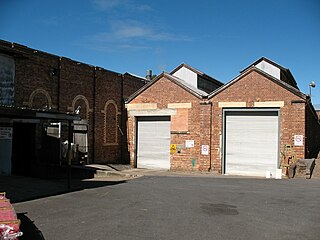
Teneriffe is an inner suburb of Brisbane, Australia, 2.5 kilometres (1.6 mi) north-east of the CBD. lt borders Fortitude Valley to the north-west, Newstead to the north and New Farm to the west and south.

McWhirters is a heritage-listed former department store at Wickham Street, Fortitude Valley, City of Brisbane, Queensland, Australia. It is also known as McWhirters Marketplace, McWhirters & Son Ltd, and Myer. It was added to the Queensland Heritage Register on 21 October 1992.
The Woolstore Precinct is a residential area in the suburb of Teneriffe in Brisbane, Australia. A former industrial and commercial area, it has undergone urban renewal with preservation and re-purposing of many buildings from the early 20th century. This renewal has been guided by neighbourhood plans formulated by Brisbane City Council, with advice from the Queensland Heritage Council.

Goldsbrough Mort Woolstore is a heritage-listed warehouse at 88 Macquarie Street, Teneriffe, City of Brisbane, Queensland, Australia. It was built c. 1933 by Stuart Brothers (Sydney). It was added to the Queensland Heritage Register on 21 October 1992.

Australian Estates No.1 Store is a heritage-listed former warehouse and now apartments at 50 Macquarie Street, Teneriffe, Brisbane, Queensland, Australia. It was designed by Montague Stanley and built from c. 1926 to 1927 by Stuart Brothers (Sydney). It is now known as the Saratoga Woolstore Apartments. It was added to the Queensland Heritage Register on 21 October 1992.

Australian Estates No. 2 Store is a heritage-listed former warehouse and now apartments at 24 Macquarie Street, Teneriffe, City of Brisbane, Queensland, Australia. It was built c. 1957. It was added to the Queensland Heritage Register on 21 October 1992.

Elder Smith Woolstore is a heritage-listed warehouse at 64 Macquarie Street, Teneriffe, City of Brisbane, Queensland, Australia. It was designed by Montague Stanley and built in 1926 by Stuart Brothers (Sydney). It was added to the Queensland Heritage Register on 21 October 1992.

Mactaggarts Woolstore is a heritage-listed wool warehouse at 53 Vernon Terrace, Teneriffe, City of Brisbane, Queensland, Australia. It was built in 1926 by Stuart Brothers (Sydney). It was added to the Queensland Heritage Register on 21 October 1992.

Winchcombe Carson Woolstores is a heritage-listed warehouse at 54 Vernon Terrace, Teneriffe, City of Brisbane, Queensland, Australia. It was designed by architect Claude William Chambers and built in 1910-11 by Stuart Brothers of Sydney who extended it in 1934. The woolstore was added to the Queensland Heritage Register on 21 October 1992.

Australian Mercantile Land & Finance Woolstores is a heritage-listed former warehouse now apartments at 34 Vernon Terrace, Teneriffe, City of Brisbane, Queensland, Australia. Designed by Robin Dods of Hall and Dods, the first woolstore was built in 1912 by Walls & Juster and the second was built in 1922. They were added to the Queensland Heritage Register on 21 October 1992.

Teneriffe Village is a heritage-listed warehouse at 110 Macquarie Street, Teneriffe, City of Brisbane, Queensland, Australia. It was built from 1955 to 1957. It is also known as Dalgety & Co. Ltd No 3 Woolstore, Queensland Primary Producers, No 8 Woolstore, and Paddys Market. It was added to the Queensland Heritage Register on 21 October 1992.

Teneriffe House is a heritage-listed villa at 37 Teneriffe Drive, Teneriffe, City of Brisbane, Queensland, Australia. It was designed by William Henry Ellerker and built in 1865. It was added to the Queensland Heritage Register on 14 May 1993.

Queensland Woollen Manufacturing Company mill is a heritage-listed mill at 42 & 42B The Terrace, North Ipswich, City of Ipswich, Queensland, Australia. It is also known as Australian Fabric Manufacturers Ltd and Boral Hancock Plywood. It was added to the Queensland Heritage Register on 19 September 2008.

Kilcoy Homestead is a heritage-listed homestead at Kilcoy-Murgon Road, Winya, Somerset Region, Queensland, Australia. It was built c. 1857. It was added to the Queensland Heritage Register on 21 October 1992.

Cahill's Stores is a heritage-listed commercial building at 232 - 234 Quay Street, Rockhampton, Rockhampton Region, Queensland, Australia. It was designed by John William Wilson and built in 1889. It is also known as Central Queensland Livestock Co-operative Society, Clarke's Building, Flamingos Nightclub, Stadium Nightclub, Dalgety & Co., WG Murray Ltd, Inglis Ltd, and Kerrisk Bros. It was added to the Queensland Heritage Register on 21 October 1992.

Goldsbrough Mort Building is a heritage-listed warehouse at 238 Quay Street, Rockhampton, Rockhampton Region, Queensland, Australia. It was built in 1899. It is also known as Drug Houses of Australia Ltd, Queensland Druggists Building, and Taylors Elliots & Australian Drug Ltd. It was added to the Queensland Heritage Register on 30 January 2004.

The Dalgety Offices is a heritage-listed office building at 1-13 Sturt Street, Townsville CBD, City of Townsville, Queensland, Australia. It was designed by Walter Hunt and built from 1923 to 1925 by William Hornby Turner. It is also known as Sunskill House. It was added to the Queensland Heritage Register on 26 August 2005.
Woolstore or Woolstores may refer to:
One of the first big businesses that developed in the new colony of Australia was the wool industry. It had an important impact on the development of Geelong as the centre of wool sales and exports. Geelong's location and the ambition of local merchants made it perfect for shipping Australian wool worldwide. As the industry boomed, throughout Geelong large storehouses were built for the storage, assessment, sale and transport of wool bales from throughout Victoria and even further.

Hinchcliff House is a heritage-listed former wool store, hostel for homeless men and university campus at 5–7 Young Street, Sydney, City of Sydney, New South Wales, Australia. The southern section was built c. 1860, while the northern section was built in the 1880s. It is also known as Hinchcliff's Woolstore, Ozanam House and EF House. It was added to the New South Wales State Heritage Register on 2 April 1999.



















